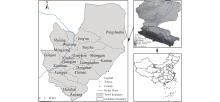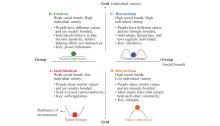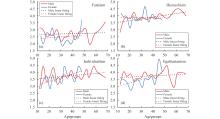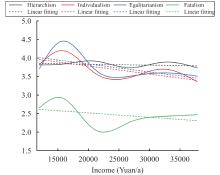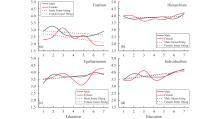Sciences in Cold and Arid Regions ›› 2018, Vol. 10 ›› Issue (5): 436–446.doi: 10.3724/SP.J.1226.2018.00436
• • 上一篇
Sociodemographic characteristics, cultural biases, and environmental attitudes: An empirical application of grid-group cultural theory in Northwestern China
FangLei Zhong1,2,*( ),AiJun Guo2,XiaoJuan Yin3,JinFeng Cui2,Xiao Yang2,YanQiong Zhang4
),AiJun Guo2,XiaoJuan Yin3,JinFeng Cui2,Xiao Yang2,YanQiong Zhang4
- 1 Key Laboratory of Ecohydrology of Inland River Basin, Northwest Institute of Eco-Environment and Resources, Chinese Academy of Sciences, Lanzhou, Gansu 730000, China
2 School of Economics, Lanzhou University, Lanzhou, Gansu 730000, China
3 Institute For Public Policy, Gansu Academy of Social Sciences, Lanzhou, Gansu 730000, China
4 School of Foreign Languages, Lanzhou University of Finance and Economics, Lanzhou, Gansu 730000, China
| 1 |
Blais-McPherson M, Rudiak-Gould P Strengthening inter-disciplinary and inter-ideological collaboration on REDD: a cultural theory approach. Global Environmental Change 2017; 42: 13- 23.
doi: 10.1016/j.gloenvcha.2016.10.008 |
| 2 |
Cheng GD, Li X, Zhao WZ, et al. Integrated study of the water-ecosystem-economy in the Heihe River Basin. National Science Review 2014; 1: 3 413- 428.
doi: 10.1093/nsr/nwu017 |
| 3 |
Dake K Myths of nature: culture and the social construction of risk. Journal of Social Issues 1992; 48: 4 21- 37.
doi: 10.1111/j.1540-4560.1992.tb01943.x |
| 4 | Daniels SE, Walker GB, 2001. Working through Environmental Conflict: the Collaborative Learning Approach. Westport: Praeger Publishers. |
| 5 | De Moor R, 1995. Values in Western Societies. Tilburg: Tilburg University Press. |
| 6 | Douglas M, 1970. Natural symbols: explorations in cosmology. London: Barie and Rockliff. |
| 7 | Douglas M, Wildavsky A, 1983. Risk and Culture. Berkeley: University of California Press. |
| 8 |
Eckersley R Green politics and the new class: selfishness or virtue?. Political Studies 1989; 37: 2 205- 223.
doi: 10.1111/j.1467-9248.1989.tb01479.x |
| 9 |
Ellis RJ, Thompson F Culture and the environment in the Pacific Northwest. American Political Science Review 1997; 91: 4 885- 897.
doi: 10.2307/2952171 |
| 10 | Ester P, De Moor R, Halman L, 1994. The individualizing society: value change in Europe and North America. Tilburg: Tilburg University Press. |
| 11 |
Grendstad G Party followership and leadership in Norway: a political culture approach. Party Politics 1995; 1: 2 221- 243.
doi: 10.1177/1354068895001002003 |
| 12 |
Grendstad G Grid-Group theory and political orientations: effects of cultural biases in Norway in the 1990s. Scandinavian Political Studies 2000; 23: 3 217- 244.
doi: 10.1111/1467-9477.00037 |
| 13 |
Grendstad G, Sundback S Socio-demographic effects on cultural biases: a nordic study of grid-group theory. Acta Sociologica 2003; 46: 4 289- 306.
doi: 10.1177/0001699303464002 |
| 14 |
Halik A, Verweij M Socio-cultural diversity and public preferences for coral reef management options in Indonesia. Ocean & Coastal Management 2018; 162: 13- 23.
doi: 10.1016/j.ocecoaman.2017.08.012 |
| 15 | Harding S, Phillips D, Fogarty M, 1986. Contrasting values in Western Europe: unity, diversity and change. London: Macmillan. |
| 16 | Hildyard N, Hegde P, Wolvekamp P, et al. Same platform, different train: the politics of participation. Unasylva 1998; 49: 194 26- 34. |
| 17 |
Hoekstra AY Appreciation of water: four perspectives. Water Policy 1998; 1: 6 605- 622.
doi: 10.1016/S1366-7017(99)00013-6 |
| 18 |
Hoogstra MA, Schanz H The future orientation of foresters: an exploratory research among Dutch foresters into the prerequisite for strategic planning in forestry. Forest Policy and Economics 2008; 10: 4 220- 229.
doi: 10.1016/j.forpol.2007.10.004 |
| 19 |
Hoogstra-Klein MA, Permadi DB, Yasmi Y The value of cultural theory for participatory processes in natural resource management. Forest Policy and Economics 2012; 20: 99- 106.
doi: 10.1016/j.forpol.2011.12.001 |
| 20 | Jenkins-Smith HC, Smith WK, 1994. Ideology, culture, and risk perception. In: Coyle DJ, Ellis RJ (eds.). Politics, Policy and Culture. Oxford: Westview Press, pp. 17–32. |
| 21 |
Kahan DM, Braman D, Gastil J, et al. Culture and identity-protective cognition: explaining the white-male effect in risk perception. Journal of Empirical Legal Studies 2007; 4: 3 465- 505.
doi: 10.1111/j.1740-1461.2007.00097.x |
| 22 |
Kahan DM, Braman D, Slovic P, et al. Cultural cognition of the risks and benefits of nanotechnology. Nature Nanotechnology 2009; 4: 2 87- 90.
doi: 10.1038/nnano.2008.341 |
| 23 |
Kahan DM, Jenkins-Smith H, Braman D Cultural cognition of scientific consensus. Journal of Risk Research 2011; 14: 2 147-` 174.
doi: 10.1080/13669877.2010.511246 |
| 24 |
Marris C, Langford IH, O'Riordan T A quantitative test of the cultural theory of risk perceptions: comparison with the psychometric paradigm. Risk Analysis 1998; 18: 5 635- 647.
doi: 10.1111/j.1539-6924.1998.tb00376.x |
| 25 |
O'Riordan T, Jordan A Institutions, climate change and cultural theory: towards a common analytical framework. Global Environmental Change 1999; 9: 2 81- 93.
doi: 10.1016/S0959-3780(98)00030-2 |
| 26 | Oltedal S, Moen BE, Klempe H, et al., 2004. Explaining risk perception. An evaluation of cultural theory. Trondheim: Norwegian University of Science and Technology. |
| 27 |
Peters E, Slovic P The role of affect and worldviews as orienting dispositions in the perception and acceptance of nuclear power. Journal of Applied Social Psychology 1996; 26: 16 1427- 1453.
doi: 10.1111/j.1559-1816.1996.tb00079.x |
| 28 |
Price JC, Walker IA, Boschetti F Measuring cultural values and beliefs about environment to identify their role in climate change responses. Journal of Environmental Psychology 2014; 37: 8- 20.
doi: 10.1016/j.jenvp.2013.10.001 |
| 29 | Rayner S, Malone EL, 1998. Human Choice and Climate Change. Columbus, Ohio: Battelle Press. |
| 30 |
Rippl S Cultural theory and risk perception: a proposal for a better measurement. Journal of Risk Research 2002; 5: 2 147- 165.
doi: 10.1080/13669870110042598 |
| 31 | Schwarz M, Thompson M, 1990. Divided We Stand: Redefining Politics, Technology and Social Choice. New York: University of Pennsylvania Press. |
| 32 |
Sharp L, Macrorie R, Turner A Resource efficiency and the imagined public: insights from cultural theory. Global Environmental Change 2015; 34: 196- 206.
doi: 10.1016/j.gloenvcha.2015.07.001 |
| 33 |
Sjöberg L Factors in risk perception. Risk Analysis 2000; 20: 1 1- 12.
doi: 10.1111/0272-4332.00001 |
| 34 |
Slimak MW, Dietz T Personal values, beliefs, and ecological risk perception. Risk Analysis 2006; 26: 6 1689- 1705.
doi: 10.1111/j.1539-6924.2006.00832.x |
| 35 |
Smith TW Some aspects of measuring education. Social Science Research 1995; 24: 3 215- 242.
doi: 10.1006/ssre.1995.1008 |
| 36 |
Thompson M, Wildavsky A A poverty of distinction: from economic homogeneity to cultural heterogeneity in the classification of poor people. Policy Sciences 1986; 19: 2 163- 199.
doi: 10.1007/BF02113494 |
| 37 | Thompson M, Ellis R, Wildavsky A, 1990. Cultural Theory. Boulder, Colo: Westview Press. |
| 38 |
Thompson M Cultural theory and integrated assessment. Environmental Modeling & Assessment 1997; 2: 3 139- 150.
doi: 10.1023/A:1019065412191 |
| 39 | Van den Broeck A, Heunks F, 1994. Political culture. Patterns of political orientations and behaviour. In: Ester P, Halman L, De Moor R (eds.). The Individualizing Society. Value Change in Europe and North America. Tilburg: Tilburg University Press, pp. 67–96. |
| 40 |
Van de Graaff S Understanding the nuclear controversy: an application of cultural theory. Energy Policy 2016; 97: 50- 59.
doi: 10.1016/j.enpol.2016.07.007 |
| 41 |
Verweij M, Douglas M, Ellis R, et al. Clumsy solutions for a complex world: the case of climate change. Public Administration 2006; 84: 4 817- 843.
doi: 10.1111/j.1540-8159.2005.09566.x-i1 |
| 42 |
Wildavsky A Choosing preferences by constructing institutions: a cultural theory of preference formation. The American Political Science Review 1987; 81: 1 3- 22.
doi: 10.2307/1960776 |
| 43 | Wildavsky A, Dake K Theories of risk perception: who fears what and why?. Daedalus 1990; 119: 4 41- 60. |
| 44 | Wilmsen C, 2005. Perils on the road to participatory research in community forestry. In: Ning ZH, Abdollahi KK (eds.). Urban and Community Forestry: Working together to Facilitate Change. Baton Rouge: Southern University, pp. 49–56. |
| 45 |
Wondolleck JM, Manring NJ, Crowfoot JE Teetering at the top of the ladder: the experience of citizen group participants in alternative dispute resolution processes. Sociological Perspectives 1996; 39: 2 249- 262.
doi: 10.2307/1389311 |
| 46 | Yaffee SL, Wondolleck JM, 1997. Building bridges across agency boundaries. In: Kohm KA, Franklin JF, Thomas JW, et al. (eds.). Creating a Forestry for the 21st Century: the Science of Ecosystem Management. Washington: Island Press, pp. 381–396. |
| No related articles found! |

